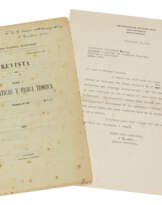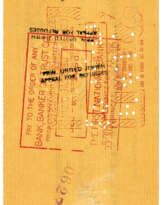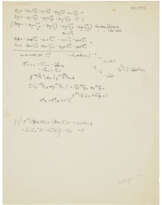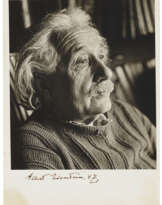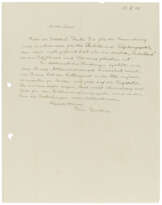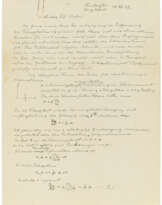ID 794443
Lot 230 | EINSTEIN, Albert (1879-1955)
Estimate value
£ 30 000 – 50 000
'Erklärung der Perihelbewegung des Merkur aus der allgemeinen Relativitätstheorie.' [Offprint from:] Preussische Akademie der Wissenschaften, Sitzungsberichte, XLVII. Berlin: 1915.
Extremely rare author’s presentation offprint of the paper empirically proving the General Theory of Relativity. On 18 November 1915, Albert Einstein read this paper to assembled members of the Prussian Academy of Sciences in Berlin, announcing that his general theory of relativity was complete. The paper encompasses some of the most important ideas in modern physics, expanding upon the special theory of relativity he published in 1905. His earlier theory includes his famous equation?E?= mc2, which quantifies the relationship between the mass of an object and its?energy, while the general theory updates and refines the universal theory of gravitation developed by Isaac Newton in the 17th century.
This is the first publication of Einstein's first post-Newtonian results, and it is of the greatest historical importance. It derives directly from Einstein and Michele Besso’s Manuscript on General Relativity, 1913-1914. In this 54-page manuscript (sold for €11,656,560, 23 November 2021, Christie’s Paris), the two friends attempt to explain an?anomaly?in?Mercury’s?orbit using versions of the equations Einstein would use to prove his theory of general relativity.
Newtonian theory correctly predicted that all planets precess in their elliptical orbits around the Sun, i.e. their orbits rotate, due to the gravitational pull of the planets upon one another. However, Mercury’s orbit is anomalous, and its point of closest approach to the sun, its perihelion, cannot be predicted by Newtonian equations. The discrepancy of 43 seconds of arc per century (one second of arc = 1⁄3600 degrees) between Newtonian prediction and observation can only be accounted for by the Einsteinian concept of the curvature of spacetime.
This 1915 article can be said to be the catalyst for Einstein's completion of the general theory of relativity. Although the Einstein-Besso manuscript contains an ingenious calculation, it also contains some mistakes – the theory both positing a wrong value for Mercury’s perihelion motion and also failing to be compatible with the relativity of rotation – errors which Einstein sought to correct in preparing the present article for publication in September 1915. Having concluded that a new set of field equations was necessary in order to eliminate these errors, Einstein was led to reconsider ideas he had previously rejected in the Zurich notebook of some three years earlier. Using these earlier ideas, Einstein was able to rapidly complete the general theory of relativity in the form we know it today and as published in the present paper.
It is not hard to imagine Einstein's excitement when he inserted the numbers for Mercury into the theory's revised mathematical framework and found the result to be 43", in agreement with observation. As he later told a colleague, he was so excited about this result that it gave him heart palpitations.
This author’s offprint can be distinguished from the normal ‘trade’ edition by the statement ‘Überreicht vom Verfasser’ on the wrapper. Very rare as author’s offprint. Weil 76.
Quarto (255 x 180mm). Original printed orange wrappers (central vertical crease, light spotting and browning).
Special notice
This lot has been imported from outside of the UK for sale and placed under the Temporary Admission regime. Import VAT is payable at 5% on the hammer price. VAT at 20% will be added to the buyer’s premium but will not be shown separately on our invoice.
| Artist: | Albert Einstein (1879 - 1955) |
|---|---|
| Place of origin: | Western Europe, Germany, Europe |
| Auction house category: | Printed books |
| Artist: | Albert Einstein (1879 - 1955) |
|---|---|
| Place of origin: | Western Europe, Germany, Europe |
| Auction house category: | Printed books |
| Address of auction |
CHRISTIE'S 8 King Street, St. James's SW1Y 6QT London United Kingdom | |
|---|---|---|
| Preview |
| |
| Phone | +44 (0)20 7839 9060 | |
| Buyer Premium | see on Website | |
| Conditions of purchase | Conditions of purchase |





